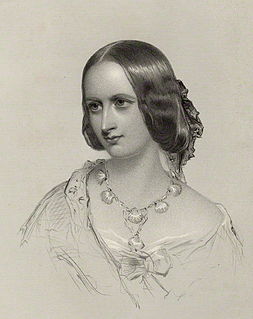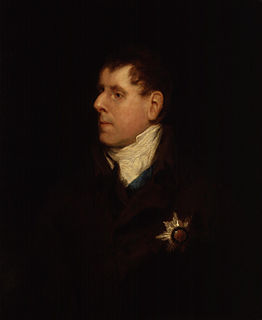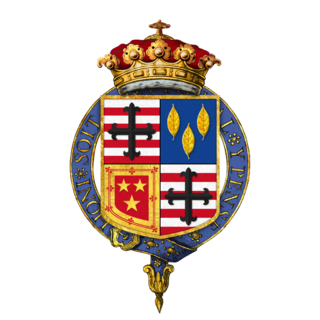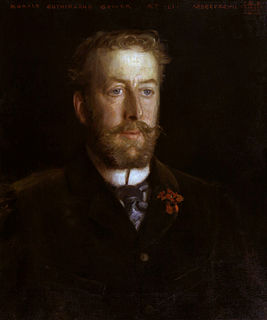
Duke of Sutherland is a title in the Peerage of the United Kingdom which was created by William IV in 1833 for George Leveson-Gower, 2nd Marquess of Stafford. A series of marriages to heiresses by members of the Leveson-Gower family made the Dukes of Sutherland one of the richest landowning families in the United Kingdom. The title remained in the Leveson-Gower family until the death of the 5th Duke of Sutherland in 1963, when it passed to John Egerton, 5th Earl of Ellesmere.

Earl of Sutherland is a title in the Peerage of Scotland. It was created circa 1230 for William de Moravia and is the premier earldom in the Peerage of Scotland. The Earl or Countess of Sutherland is also the Chief of Clan Sutherland.

Earl Granville is a title that has been created twice, once in the Peerage of Great Britain and once in the Peerage of the United Kingdom. It is now held by members of the Leveson-Gower family.

Earl of Cromartie is a title that has been created twice, both for members of the Mackenzie family. It was first created as Earl of Cromarty in the Peerage of Scotland in 1703 for Sir George Mackenzie, 2nd Baronet, but his titles were forfeited after the Jacobite rising of 1745. It was recreated in 1861 in the Peerage of the United Kingdom for Anne Sutherland-Leveson-Gower, Duchess of Sutherland. Since 1979, the Earl of Cromartie has been chief of Clan Mackenzie.

Earl of Ellesmere, of Ellesmere in the County of Shropshire, is a title in the Peerage of the United Kingdom. It was created in 1846 for the Conservative politician Lord Francis Egerton. He was granted the subsidiary title of Viscount Brackley, of Brackley in the County of Northampton, at the same time, also in the Peerage of the United Kingdom. Born Lord Francis Leveson-Gower, he was the third son of George Leveson-Gower, 1st Duke of Sutherland and Elizabeth Gordon, 19th Countess of Sutherland. In 1803 his father had inherited the substantial estates of his maternal uncle Francis Egerton, 3rd Duke of Bridgewater. On his father's death in 1833, Lord Francis succeeded to the Egerton estates according to the will of the late Duke of Bridgewater, and assumed by Royal licence the surname of Egerton in lieu of Leveson-Gower. The Brackley and Ellesmere titles created for him in 1846 were revivals of titles held by the Dukes of Bridgewater. In 1963 his great-great-grandson, the fifth Earl, succeeded his kinsman as 6th Duke of Sutherland. The earldom of Ellesmere and viscountcy of Brackley are now subsidiary titles of the dukedom.

Anne Sutherland-Leveson-Gower, Duchess of Sutherland VA, 1st Countess of Cromartie in her own right and known as the Marchioness of Stafford from 1849 to 1861, was a British peeress.

Elizabeth Georgiana Campbell, Duchess of Argyll was a British noblewoman and abolitionist. Born into the wealthy Sutherland-Leveson-Gower family, she was the eldest daughter of the 2nd Duke of Sutherland by his wife, the political hostess Lady Harriet Howard. In 1844 Elizabeth married George Campbell, Marquess of Lorne, eldest son and heir to the 7th Duke of Argyll. She became the Duchess of Argyll in 1847 when her husband succeeded his father.

Harriet Elizabeth Georgiana Sutherland-Leveson-Gower, Duchess of Sutherland, styled The Honourable Harriet Howard before her marriage, was Mistress of the Robes under several Whig administrations: 1837–1841, 1846–1852, 1853–1858, and 1859–1861; and a great friend of Queen Victoria. She was an important figure in London's high society, and used her social position to undertake various philanthropic undertakings including the protest of the English ladies against American slavery.
The Duchess of Sutherland is the wife of the Duke of Sutherland, an extant title in the Peerage of the United Kingdom which was created by William IV in 1833.

Granville Leveson-Gower, 1st Marquess of Stafford PC, known as Viscount Trentham from 1746 to 1754 and as The Earl Gower from 1754 to 1786, was a British politician from the Leveson-Gower family.

George Granville Leveson-Gower, 1st Duke of Sutherland KG, PC, known as Viscount Trentham from 1758 to 1786, as Earl Gower from 1786 to 1803 and as The Marquess of Stafford from 1803 to 1833, was an English politician, diplomat, landowner and patron of the arts from the Leveson-Gower family. He was the wealthiest man in Britain during the latter part of his life. He remains a controversial figure for his role in the Highland Clearances.

George Granville William Sutherland-Leveson-Gower, 3rd Duke of Sutherland KG FRS, styled Viscount Trentham until 1833, Earl Gower in 1833 and Marquess of Stafford between 1833 and 1861, was a British politician from the Leveson-Gower family.

Cromartie Sutherland-Leveson-Gower, 4th Duke of Sutherland,, styled Lord Cromartie Sutherland-Leveson-Gower until 1858, Earl Gower between 1858 and 1861 and Marquess of Stafford between 1861 and 1892, was a British peer and politician from the Leveson-Gower family.
The Lord Lieutenant of Sutherland is the British monarch's personal representative in an area which has been defined since 1975 as consisting of the local government district of Sutherland in Scotland, and this definition was renewed by the Lord-Lieutenants (Scotland) Order 1996. Previously, the area of the lieutenancy was the county of Sutherland, which was abolished as a local government area by the Local Government (Scotland) Act 1973. The district was created, under the 1973 act as a district of the two-tier Highland region and abolished as a local government area under the Local Government (Scotland) Act 1994, which turned the Highland region into a unitary council area.

Lord Ronald Charles Sutherland-Leveson-Gower, known as Lord Ronald Gower, was a Scottish Liberal politician, sculptor and writer from the Leveson-Gower family.
Frederick Neville Sutherland Leveson-Gower, was a British Liberal Unionist Party politician from the Leveson-Gower family.
Cromartie or Cromarty may refer to:
Sutherland is a surname which may refer to:













